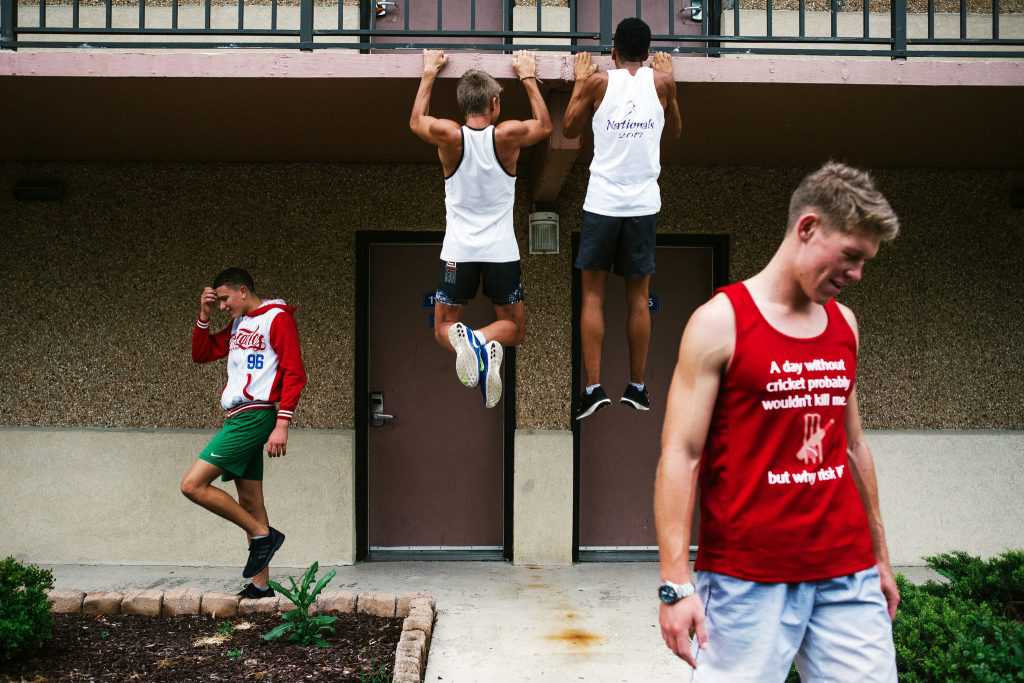
When the first high school track and field team from Namibia to compete at the Penn Relays arrived in Philadelphia from Grootfontein, a town of about 25,000 people, Henk Botha, the school’s principal and shot-put and discus coach, knew the trip would be an eye-opener.
The population of Grootfontein, you see, is barely larger than the total number of athletes, about 18,000, who competed in this year’s relays, held April 27-29. But that huge crowd wasn’t the only thing that would be new for the teenagers Botha brought from Grootfontein Agri College, a school of 183 students that he helped found several years ago. Most of his athletes had never been out of southern Africa. A handful had never flown. But Botha felt his team was ready, and he was certain the experience would be worth it.
“In the U.S., you’re used to a high level of competition,” he said. “In Namibia, you have to seek that out.”
The journey nearly ended before it began, when the main sponsor pulled out a few weeks before the team was scheduled to depart. A parent at the school stepped in with a loan to finance the trip — on the condition that the money would be repaid by reinvesting in the school — but that only got Grootfontein on its way.
When the team arrived in New York after a 23-hour trip, and only days before the relays were to begin, the students found that the hostel rooms they had reserved in Union City, N.J., were not available. While waiting hours for a solution, the coaches and athletes ordered pizza to fill the time and their stomachs, sharing the food off paper plates in a dim hallway lined with exposed pipes.

Because the reservation mix-up meant the hostel could not accommodate the entire team, a parent arranged for two of the athletes, Xu Huber, 14, and Felicia Liswaniso, 15, to move into a hotel room about 10 minutes away, in North Bergen, N.J. The next day, the rest of the team joined them there after a single night in the hostel. “We always stay together as a team; it feels weird to be separated,” said Liswaniso, who passed time by letting Huber braid her hair.

The team had planned to spend an entire day sightseeing in New York City before going to Philadelphia for the relays, but after the hostel episode and a half-day spent moving into the hotel, the athletes settled for a visit to the one place everyone had agreed upon: Times Square.
“I didn’t think it would be this huge,” Chantel Louw, 16, said. The team members marveled at the giant video screens, took photographs with street performers and bought souvenirs. Then they packed and headed for Philadelphia.


In the parking lot of a Howard Johnson in Blackwood, N.J., the team’s home base for the meet, Karlien Botha used a towel to work on her discus form while her teammates practiced baton handoffs. Botha, 15, is considered one of the best discus throwers in Namibia.
She turned in a personal best of 39.95 meters the week before arriving in the United States and hoped to throw 40 meters at Franklin Field. Instead, she topped out at 35.88. In Namibia, discus throwers are given six attempts, allowing them time to warm up; at the Penn Relays, they were allotted three. “I didn’t expect this,” she said. “It’s so big and overwhelming, I was so stressed. Next time I come, I just need to relax and take my time in the circle.”

Chrislene Klein-Nienaber, 13, stretched before warm-ups for the high jump. Normally, she said, she starts at 1.45 meters when competing. At the Penn Relays, the starting mark was 1.59 — already higher than the high school record she holds in Namibia. She cleared the bar on her first attempt — “It was really high” — but was unable to get over the next height, 1.63 meters, on three attempts.

The Penn Relays divides competitors into two categories: unique and nonunique athletes. Unique athletes specialize in one running or field event, while nonunique athletes compete in multiple events and relays. Unique athletes made up 13,000 of the 18,000 participants this year. “Remember,” Coach Botha had told the team, “you did not come here to just be participants. You came to be competitors.”

Ian Grobbelaar, 15, Jaco Grobbelaar, 17, Lincoln Beukes, 16, and Raymond Hummel, 15, waited in the shade until their 4×100-meter relay heat was called. “There are only three racing tracks in all of Namibia, and none of them are close to our town,” Jaco Grobbelaar said. “The only time we come to a real track is to run, not to practice. For us, it’s a privilege to race here.” The boys finished in 44.37 seconds, placing second in their heat Friday. They went on to another second-place finish on Saturday, with the 4×400-meter relay finishing in 3 minutes 29.87 seconds.


With their events completed, the Namibians watched from the mezzanine as other high schools, colleges and Olympians competed on the relays’ final day.

While Botha, their coach, and some of their teammates napped, the others soaked up their final hours in Philadelphia. The next day, the team was to return to Africa, some directly to Zimbabwe to represent their country in a regional championship. “This whole trip opened my eyes,” Ian Grobbelaar said. “You may be the best in Namibia, but there’s always someone out there better than you.”

We’re interested in your feedback on this page. Tell us what you think.




























